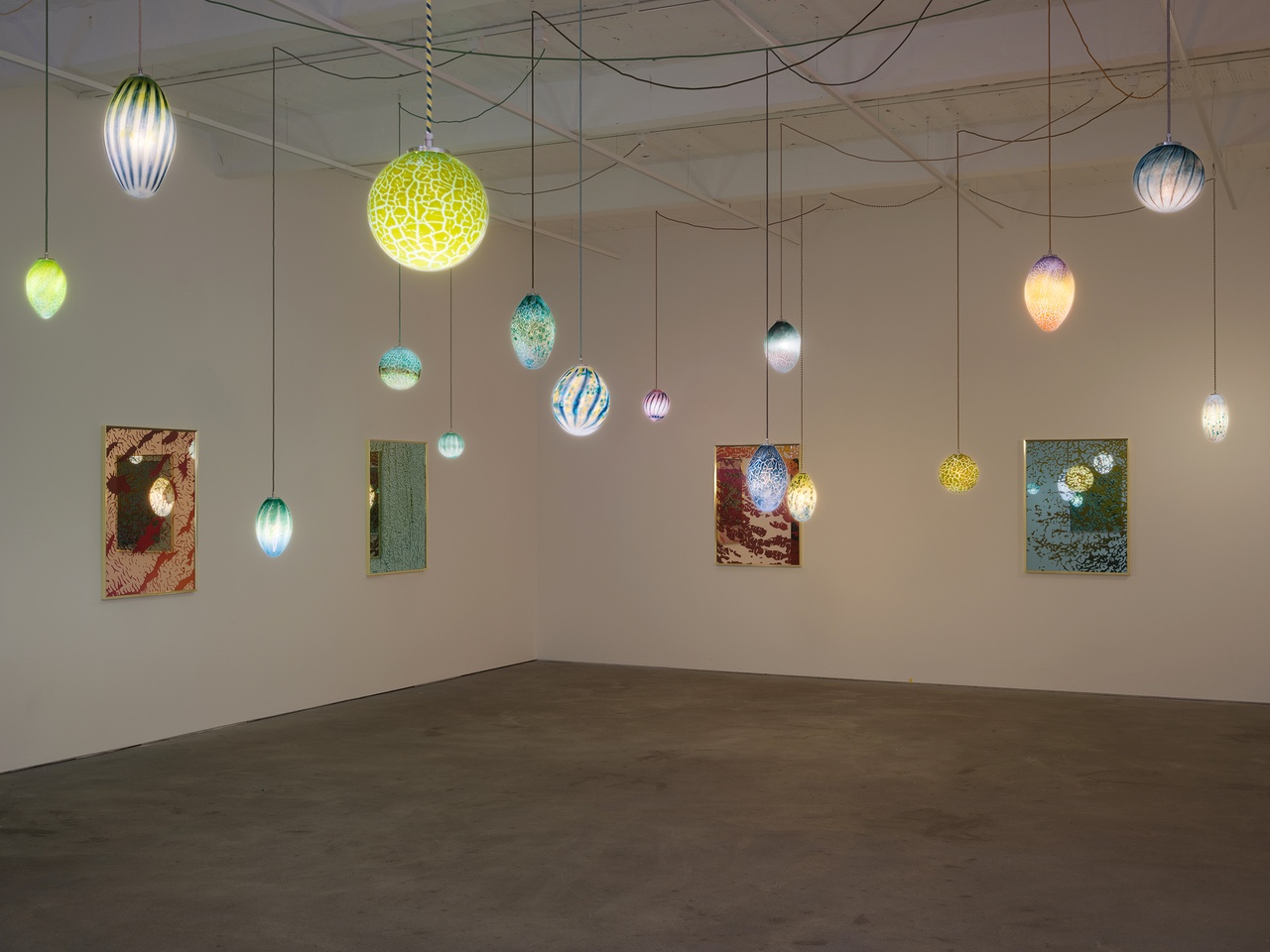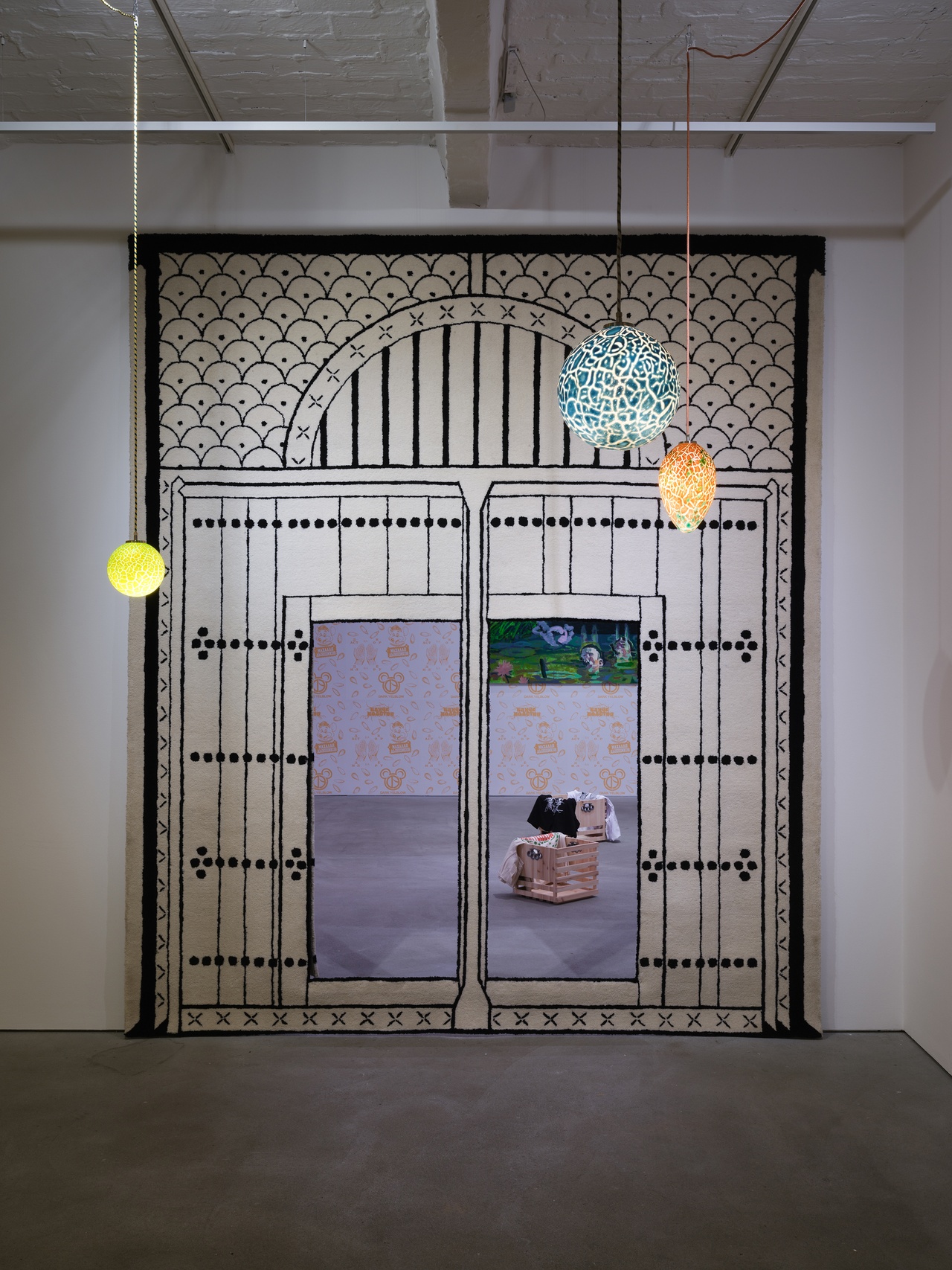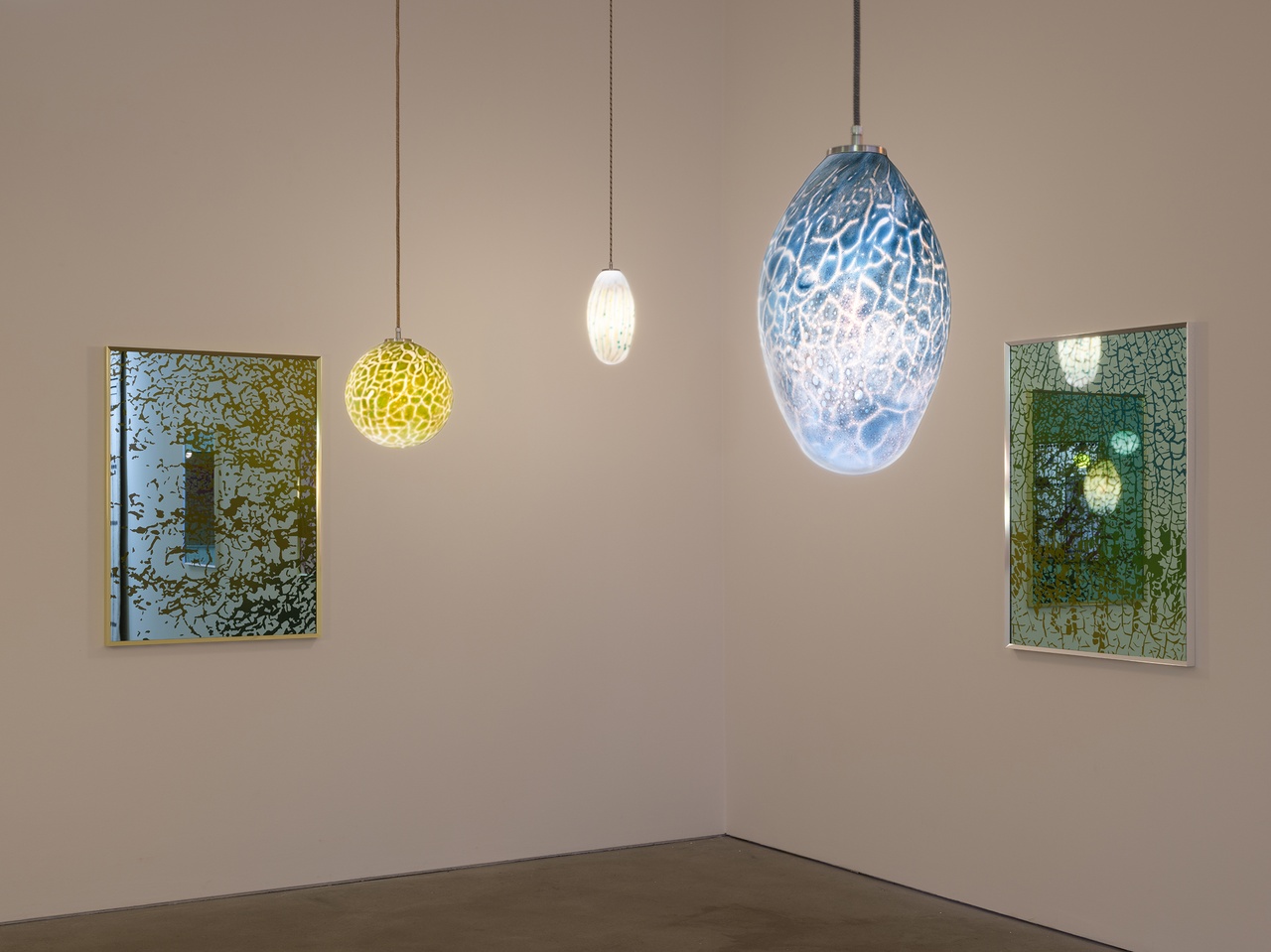DIVINE TRUTHS FALLEN THROUGH THE CRACKS Max L. Feldman on Slavs and Tatars at Kraupa-Tuskany-Zeidler, Berlin

“Slavs and Tatars featuring Andrey Anro, Dozie Kanu, Mina Masoumi, Lin May Saeed: Hang Don’t Cut,” Kraupa-Tuskany Zeidler, Berlin, 2023, installation view
In the three books of Galen’s De alimentorum facultatibus (On the Properties of Foodstuffs), the Greek Roman physician says that melons are “greatly inferior” to seasonal fruits, but better than gourds – less likely to make us vomit, though eating their seeds “brings about purgation.” [1] The transnational art collective Slavs and Tatars’ exhibition “Hang Don’t Cut” is, however, inspired by the cultural meanings of melons not in the ancient world but Central Asia today. Its two most prominent sets of works are a series of blown-glass lamps in the shape of the fruit, and mirrors printed with furrowed marks inspired by their skins. Both are relatively typical of the collective’s work insofar as they tell stories about and give visual form to their approach to the idea of “hybridity.” In this exhibition, though, it becomes possible to read another theme in their work. This has gone unmentioned in criticism but is implicitly present throughout their oeuvre: tragedy.
Dark Yelblow (2023) consists of 20 greenish-yellow glass lamps dangling from the ceiling of the gallery. Each one looks scored with tiny uneven valleys, fissures like those that can be seen in the skin of many kinds of melon, each unique to one item of fruit amid millions of others. This figure reappears in flattened form in acrylic paint in a series of ten distorted reverse glass mirrors (all 2023). All of them are officially untitled, but each piece is designated as Fапча or Kапча (“Gaptcha” or “Qaptcha”), since they all feature a “CAPTCHA” (Completely Automated Public Turing test to tell Computers and Humans Apart) hidden within the texture of the melon skin. The viewer can read Cyrillic words in the documentation that accompanies the exhibition, but not in the mirrors themselves, which remain anonymous, nameable only by the color and pattern of the melon skins visible on the glass.
The cutouts in Sanft Power (2022), a white carpet marked with the patterns of an ornate doorway, allow it to act as a portal into a second room featuring seven works by Andrey Anro, Dozie Kanu, Mina Masoumi, and Lin May Saeed, some of whom have roots in places referenced in Slavs and Tatars’ oeuvre (Belarus, Iran). While the works of these artists are still a part of “Hang Don’t Cut,” Sanft Power separates them from Dark Yelblow and the mirrors both physically and thematically, since they don’t reference melons. This is vital, as Slavs and Tatars’ lamps and mirrors can be read as allegories deriving from one Central Asian myth about the origins of human knowledge, which is tragically obscured from us in the very source in which it is supposed to be revealed. Their allegorical significance and tragic form has less to do with what they look like, or the connotations of lamps (enlightenment) or mirrors (self-reflection), than with how these objects reference the myth while neither reconciling the story with reality, nor suggesting this is possible.

“Slavs and Tatars featuring Andrey Anro, Dozie Kanu, Mina Masoumi, Lin May Saeed: Hang Don’t Cut,” Kraupa-Tuskany Zeidler, Berlin, 2023, installation view
According to this myth, which is a culturally specific elaboration of Islamic scripture, melons originally grow in Jannāt ‘adni (the Gardens of Eden or Gardens of Perpetual Residence), as part of the ecosystem of paradise. The story tells of how Allah decided one day to give the fruit to humanity as a magnificent, juicy gift. This came, however, with a secret message inscribed by the Creator in the skin of the fruit. Human beings couldn’t help but notice that the little cracks in the skin of the melon looked not unlike Arabic script: the divine Word etched into something that could be seen and eaten every day. Since the patterns are never repeated, each melon comes with a distinctive arrangement of cracks that also promises a new, specific form of knowledge, unlocking the key to previously unthought truths, though they can never be total or whole. But the people were unable to read Allah’s message.
This shares the kind of paradoxical form that may be familiar from Greek myths and tragedies, in which a wretched protagonist fails to know the truth about themselves even when the clues are everywhere. Even if the content is not the same, the lost messages in the melons share a form with the story of Cassandra, who was fated to tell true prophecies that went unbelieved. In the story of the melons, however, the meaning of God’s message is missed by those who wish to know – the divine secret forever unknown, the dancing calligraphy illegible, known only in fragments that can never be completed.
Today, the exhibition text explains, blessed as human beings are with processing and storage techniques, the myth comes with a political-economic backbone. During the pitiless Central Asian winter, as the wind howls round peaks, storming the endless barren steppes, melons are stored in warehouses so that they can be eaten during the first frosts, a feat as miraculous as Allah’s lost messages. Plus, as Slavs and Tatars emphasize in the text, in an act of transliteration that is typical of their approach to making art, the etymology of the word “melon” in Slavic languages derives from the verb дыть, meaning “to blow” (hence the invented portmanteau “Yelblow,” intensifying a possible visual and taxonomical association with honeydew melons), as in the way the dangling bulbs and mirrors on the walls are produced. This is a form of human ingenuity comparable to the farming processes that mean the people of Central Asia can eat melons in the desolate gloom, perhaps a compensation for the unread divine Word. And, ultimately, the melons are allegories not just of divine miscomprehension, but of hybridity and tragedy.
There is room to argue that the concept of hybridity, developed by Homi K. Bhabha (and others), helps describe Slavs and Tatars’ deliberately unwieldy concept of “Eurasia,” which they essentially define as the vast area stretching from former East Berlin to the Sino-Russian border. Hybridity captures how identities are produced “in between” dominant ideas or stories under, as Bhabha puts it, “conditions of contingency and contradictoriness” [2] that do not make any of them more important than any other. This certainly applies to Slavs and Tatars’ unusually broad idea of Eurasia in general, though this idea of Eurasia is perhaps a more ironic and less earnest context than Bhabha’s rendering could accommodate. This is a typical example of Slavs and Tatars’ strategy of deliberate imprecision, transliteration’s tricky hybridizing travel companion.
Perhaps this idea can be made more applicable to Slavs and Tatars if it is deepened with a reflexive reading of Ezequiel Adamovsky’s coinage “euro-Orientalism.” [3] This concept extends Edward W. Said’s pioneering work to describe how Slavic cultures and their subaltern people are judged as illiberal and comparatively uncivilized by Western commentators. [4] “Hang Don’t Cut” extends this beyond Europe in the openly clumsy idea that melons are important in “Central Asia.” While the artists name Uzbekistan and Xinjiang as places where these stories about melons are told, these places don’t border each other, suggesting that this idea of Central Asia subverts what Said called the Orientalist’s stabilizing gesture of “vision,” [5] which assumes the Middle East is and can only be one thing. And the humble melon can then act as a surrogate, a cipher, a reified form as rich in culinary mythology as escargots, pizza, fish and chips, herring, and Wiener schnitzel.
Central Asia certainly exists. It’s just not a catch-all term for an exotic culture like the so-called “Orient.” It does, however, name a space that stretches from at least Kazakhstan (whose western border is about 700 km from eastern Ukraine) to Xinjiang, the autonomous region of western China, whose mostly Muslim Uyghur population is currently suffering political repression and genocide at the command of the monstrous Chinese Communist Party. This definition of Central Asia has a population of just under 76 million and encompasses five (or six) now-independent countries, with at least 32 ethnic groups speaking 13 main languages (Buryat, Dari, Kalmyk, Karakalpak, Kazakh, Kyrgyz, Mongolian, Pashto, Russian, Tajik, Turkmen, Uyghur, and Uzbek). This vast expanse is partly unified by the fact that 87 percent of the population follow Islam. “Hang Don’t Cut,” however, turns the melon into a possible point of unification, glassily fossilizing those millions of faces and tongues into one succulent, vitamin-rich morsel that tells one small truth about how people live as if it expresses something much bigger while playing with a set of cinematic cliches about what these places are like.

“Slavs and Tatars featuring Andrey Anro, Dozie Kanu, Mina Masoumi, Lin May Saeed: Hang Don’t Cut,” Kraupa-Tuskany Zeidler, Berlin, 2023, installation view
Hybridity has already been discussed as a feature of Slavs and Tatars’ work. [6] The tragic dimension may, however, have been overlooked despite it being a continuous theme in the collective’s oeuvre. One example, not present in “Hang Don’t Cut” but whose implications are there in its spirit, is from the work cycle Molla Nasreddin (2011). The book that accompanies the work details the consequences of the rapid turnover of political regimes in Azerbaijan (Ottoman, brief independence, Soviet, independence again). This forced several changes to the Azeri language (from Arabic to Latin, Latin to Cyrillic, and Cyrillic back to Latin), which “essentially made Azeris immigrants in their own country, both across generations – grandparents couldn’t read the language their grandchildren were taught in school – as well as vis-à-vis their own cultural legacy,” [7] compromising the transmission of traditions, words, stories, and ideas like Allah’s indecipherable message in the melons.
There’s also a hint of this in Friendship of Nations: Polish Shi’ite Showbiz (2011). These works were made to honor the presence and cultural contributions of Polish-Jewish refugees in the Iranian city of Isfahan in the 1940s by getting Catholic Polish weavers to produce versions of colorful prayer mats used by Shia Muslims. Sometimes they used the baffling slogans of the 1980s surrealist Polish dissident group the Orange Alternative – such as “Beware the anti-imperialist imperialists!” and “Help local law enforcement: beat yourself up!” – that were originally designed to be incomprehensible to the communist authorities.
The intergenerational miscommunication in Molla Nasreddin and the looping contradictions of Polish-Shi’ite Showbiz reappear in an intensified way in “Hang Don’t Cut.” The hint of tragedy in the myth of Allah’s illegible message emphasizes how the self-division that is part of all human language is not solved by hybridity, which is only ever another kind of incomplete and sometimes awkward solution to miscommunication: “Eurasian” cultures don’t and can’t add up to a whole, but nor do the artists suggest that such a thing could ever truly be.
Read in this tragic idiom, the lamps of Dark Yelblow can appear as dangling pearls of unusable wisdom, commands that cannot be fulfilled, blessings that can be savored but never realized. The mirrors themselves, meanwhile, are readable only under conditions that force us, via CAPTCHA, to prove that we are really human: to address ourselves to a machine that could never decipher a message in the first place or enjoy the tragic mystery of a lost one. Computers do not currently enjoy emotional literacy, but they still get in between our reading eyes and the things we want to know. The two sets of works in “Hang Don’t Cut” do, however, complement each other even if and precisely because they don’t form two halves of something that could ever be put back together.
In the story Slavs and Tatars tell, the divine message can only make sense to us under completely new conditions, when the world – whose ruptured, unhappy division from itself they reflect – is put back together using the very words we fail to understand. These fractured messages can thus be read back into the euro-Orientalizing problem of “Eurasia”: a writing misread, the divine Truth unheeded, hopelessly obscured in the torrential confusion.
“Slavs and Tatars featuring Andrey Anro, Dozie Kanu, Mina Masoumi, Lin May Saeed: Hang Don’t Cut,” Kraupa-Tuskany Zeidler, Berlin, April 28–July 29, 2023.
Max L. Feldman is a writer based in London.
Image credit: Courtesy of Kraupa-Tuskany Zeidler, photos Marjorie Brunet Plaza
Notes
| [1] | Galen, On the Properties of Foodstuffs, ed. and trans. Owen Powell (Cambridge: Cambridge University Press, 2003), 74–75. |
| [2] | Homi K. Bhabha, The Location of Culture (London: Routledge, 1994), 3. |
| [3] | Ezequiel Adamovsky, Euro-Orientalism: Liberal Ideology and the Image of Russia in France (c. 1740–1880) (Oxford: Peter Lang, 2006). |
| [4] | Frantz Fanon, Black Skin, White Masks [1952], trans. Charles Lam Markmann (London: Pluto Press, 2008), 87. |
| [5] | Edward W. Said, Orientalism [1978] (London: Penguin, 2003), 240. |
| [6] | Sussan Babaie, “Geographies of the ‘Beyond’,” in Slavs and Tatars, ed. Pablo Larios (Warsaw: Ujazdowski Castle Centre for Contemporary Art; London: Walther König, 2017), 84–89. |
| [7] | Slavs and Tatars, Slavs and Tatars Presents Molla Nasreddin: The magazine that would’ve, should’ve, could’ve (Zurich: Christoph Keller, 2011), 9. |
